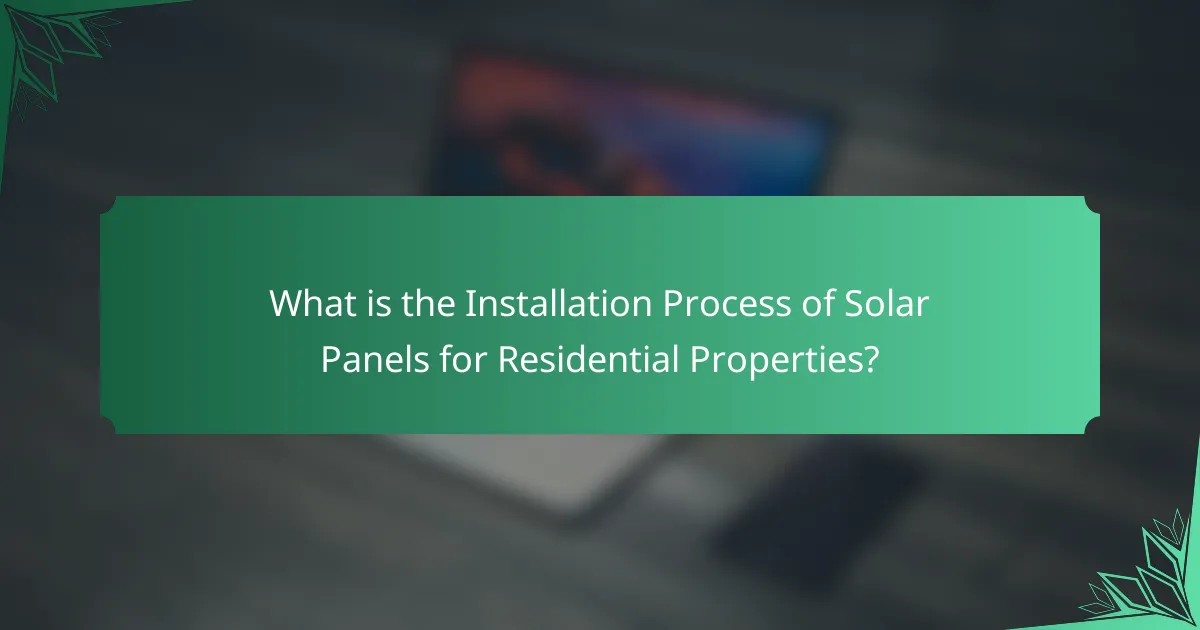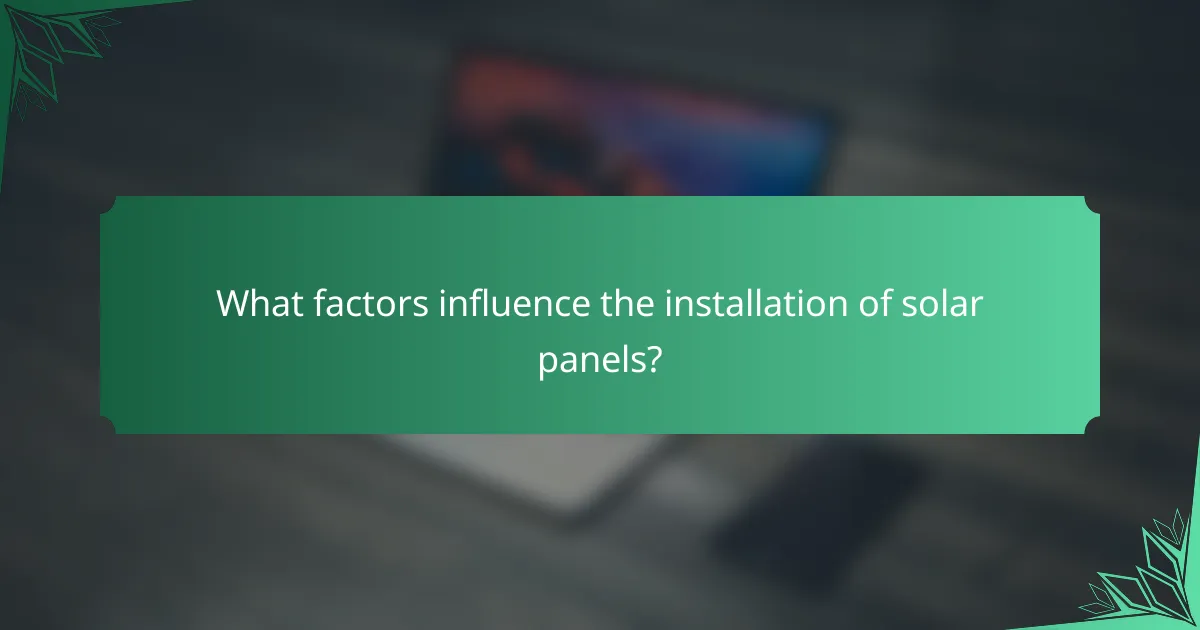
What is the Installation Process of Solar Panels for Residential Properties?
The installation process of solar panels for residential properties involves several key steps. First, a site assessment is conducted to evaluate the property’s solar potential. This includes analyzing roof orientation, shading, and structural integrity. Next, a design plan is created, detailing the number of panels and their placement. After obtaining necessary permits, the installation team mounts the solar panels on the roof or ground. They then connect the panels to an inverter, which converts solar energy into usable electricity. Finally, the system is connected to the home’s electrical system and tested for functionality. This process typically takes one to three days, depending on the system’s size and complexity.
How do solar panels work in residential settings?
Solar panels convert sunlight into electricity for residential use. They contain photovoltaic cells that absorb sunlight. When sunlight hits these cells, it generates direct current (DC) electricity. An inverter then converts this DC electricity into alternating current (AC) electricity. AC electricity is what powers household appliances. Excess electricity can be stored in batteries or fed back into the grid. This process allows homeowners to reduce energy costs and reliance on traditional power sources. Solar panels typically have a lifespan of 25 years or more, making them a long-term investment.
What are the key components of a solar panel system?
The key components of a solar panel system include solar panels, inverters, mounting systems, batteries, and charge controllers. Solar panels convert sunlight into electricity through photovoltaic cells. Inverters convert the direct current (DC) produced by solar panels into alternating current (AC) for home use. Mounting systems secure solar panels to roofs or the ground. Batteries store excess energy for use when sunlight is not available. Charge controllers regulate the flow of electricity to and from the batteries, preventing overcharging. Each component plays a crucial role in the efficiency and functionality of the solar energy system.
How do these components contribute to energy generation?
Solar panel components, including photovoltaic cells, inverters, and mounting systems, contribute to energy generation by converting sunlight into electricity. Photovoltaic cells absorb solar energy and generate direct current (DC) electricity through the photovoltaic effect. Inverters then convert this DC electricity into alternating current (AC), which is suitable for home use. The mounting systems securely hold the solar panels in place, optimizing their angle for maximum sunlight exposure. Together, these components work efficiently to harness solar energy and convert it into usable electrical power for residential properties.
What are the steps involved in the installation process?
The steps involved in the installation process of solar panels for residential properties include site assessment, design, permitting, installation, and inspection.
First, a site assessment evaluates the property’s solar potential. This involves measuring roof space and shading. Next, the design phase creates a customized solar system layout. This layout considers energy needs and local regulations.
Then, obtaining necessary permits is crucial. Permits ensure compliance with local codes and regulations. Following approval, the installation phase begins. This includes mounting solar panels and connecting electrical components.
Finally, an inspection verifies that the installation meets safety and performance standards. This step is essential for system activation and grid connection.
How do you assess the suitability of your property for solar panel installation?
To assess the suitability of your property for solar panel installation, evaluate several key factors. First, consider the roof’s orientation. South-facing roofs typically receive the most sunlight. Next, assess the roof’s pitch. A slope between 15 to 40 degrees is ideal for solar panels.
Check for any obstructions that may cast shadows on the roof. Trees, buildings, or chimneys can reduce efficiency. Evaluate the roof’s material and condition. Asphalt shingles are commonly used and suitable for solar panels.
Inspect the available space for panel installation. A minimum of 100 square feet is generally needed for an effective system. Lastly, analyze local climate conditions. Areas with high sunlight exposure yield better solar energy production.
These assessments ensure that your property can effectively support solar panel installation.
What permits and regulations must be considered before installation?
Before installing solar panels, various permits and regulations must be considered. Local zoning laws often dictate where solar panels can be installed. Building permits may be required to ensure compliance with safety standards. Electrical permits are necessary for connecting the solar system to the grid. Homeowners’ association (HOA) guidelines may impose restrictions on solar panel aesthetics. State regulations can vary, requiring adherence to specific energy codes. Federal incentives may also influence installation requirements. Compliance with these permits and regulations is crucial to avoid fines and ensure a successful installation.
How is the installation site prepared for solar panels?
The installation site for solar panels is prepared by assessing and clearing the area. First, the roof or ground space is evaluated for structural integrity. This ensures it can support the weight of the solar panels. Next, any obstructions such as trees or buildings that block sunlight are identified. These may need to be trimmed or removed.
Then, the surface is cleaned to remove debris and dirt. This is crucial for proper adhesion and installation of mounting systems. After cleaning, measurements are taken to determine the optimal placement of the panels. This ensures maximum sun exposure throughout the day.
Finally, necessary permits and inspections are obtained to comply with local regulations. This preparation process is essential for the efficiency and longevity of the solar panel system.
What is the process of mounting solar panels on a roof?
The process of mounting solar panels on a roof involves several key steps. First, a structural assessment of the roof is conducted. This ensures the roof can support the weight of the solar panels. Next, the installation area is measured and marked for panel placement. After that, mounting brackets are attached to the roof. These brackets secure the panels in place. Then, the solar panels are installed onto the brackets. This step typically involves bolting the panels down for stability. Following the panel installation, electrical wiring is connected. This wiring links the panels to the inverter and electrical system. Finally, a thorough inspection is performed to ensure everything meets safety and performance standards. Each of these steps is crucial for a successful solar panel installation.
How are electrical connections made during installation?
Electrical connections during installation are made by securely joining wires and components. This typically involves stripping insulation from wire ends. Next, the exposed wires are twisted together or connected using connectors. In solar panel installations, connections often occur at junction boxes. These boxes house the electrical connections and protect them from environmental factors. Proper torque specifications are followed to ensure tight connections. Electrical connections are tested for continuity and voltage after installation. This ensures that all components function correctly and safely.

What factors influence the installation of solar panels?
The installation of solar panels is influenced by several key factors. These factors include the availability of sunlight, local regulations, and financial incentives. Sunlight availability determines the potential energy generation from solar panels. Areas with higher sunlight exposure are more favorable for installation. Local regulations can affect installation permits and zoning laws. Compliance with these regulations is essential for a successful installation. Financial incentives, such as tax credits and rebates, can significantly reduce the overall cost of solar panel installation. These incentives encourage homeowners to invest in solar technology. Additionally, the orientation and angle of the roof impact the efficiency of solar panels. Proper installation maximizes energy production. Lastly, the type of solar technology chosen also plays a role in the installation process. Different technologies have varying installation requirements and efficiencies.
What are the common challenges faced during solar panel installation?
Common challenges faced during solar panel installation include roof suitability, weather conditions, and permitting issues. Roof suitability refers to the structural integrity and orientation of the roof. Not all roofs can support solar panels effectively. Weather conditions can delay installation processes. Rain, snow, or high winds pose safety risks and impact scheduling. Permitting issues involve navigating local regulations and obtaining necessary approvals. This process can be time-consuming and complex. Additionally, electrical connections must be handled carefully to ensure safety and compliance. Each of these challenges can impact the overall timeline and cost of solar panel installation.
How can weather conditions affect the installation process?
Weather conditions can significantly impact the installation process of solar panels. Rain can lead to slippery surfaces, increasing the risk of accidents. High winds can hinder the safe handling of materials and equipment. Extreme temperatures can affect the adhesive used in panel installation. Snow can obstruct access to rooftops, delaying the project. Additionally, cloudy weather may limit the efficiency of solar panel testing post-installation. According to the National Renewable Energy Laboratory, optimal installation occurs in dry, mild conditions to ensure safety and effectiveness.
What safety measures should be taken during installation?
Safety measures during solar panel installation include wearing personal protective equipment (PPE). This PPE should consist of hard hats, gloves, and safety glasses. Workers must also secure ladders and scaffolding to prevent falls. Proper electrical safety protocols must be followed to avoid electrocution. Grounding equipment is essential to mitigate electrical hazards. Additionally, installers should ensure that the work area is clear of debris. Adhering to local building codes is crucial for compliance and safety. Training on equipment use and emergency procedures enhances overall safety. Following these measures significantly reduces the risk of accidents during installation.
What are the costs associated with solar panel installation?
The costs associated with solar panel installation typically range from $15,000 to $25,000 for an average residential system. This price includes equipment, labor, and permits. The average cost per watt is approximately $2.50 to $3.50. Factors influencing costs include system size, panel type, and installation complexity. Additional expenses may arise from roof repairs or upgrades. Federal tax credits can reduce overall costs by up to 26%. Local incentives may also apply, further lowering the financial burden. Overall, the investment in solar panels can lead to long-term savings on energy bills.
How do different types of solar panels affect installation costs?
Different types of solar panels impact installation costs significantly. Monocrystalline panels are typically more expensive due to their higher efficiency and longer lifespan. They can cost around $1.00 to $1.50 per watt. Polycrystalline panels are more affordable, generally ranging from $0.80 to $1.20 per watt. Thin-film solar panels are the least expensive but require more space and have lower efficiency, costing about $0.70 to $1.00 per watt.
The overall installation cost also varies based on panel type. Higher efficiency panels may reduce the number of panels needed, potentially lowering labor costs. Conversely, larger, less efficient panels can increase installation time and labor expenses. A study by the National Renewable Energy Laboratory found that installation costs can vary by up to 30% based on the type of solar panel chosen.
What financing options are available for homeowners?
Homeowners have several financing options available for solar panel installation. These options include solar loans, which allow homeowners to borrow money specifically for solar projects. Another option is a solar lease, where homeowners pay a monthly fee to use the solar system without owning it. Power Purchase Agreements (PPAs) are also available, where homeowners pay for the electricity generated by the solar panels at a predetermined rate. Additionally, some homeowners may qualify for government incentives or tax credits that reduce the overall cost of installation. According to the Solar Energy Industries Association, 26% of the cost of solar systems may be covered by federal tax credits. This makes financing options more accessible for homeowners looking to invest in solar energy.

What are the best practices for a successful solar panel installation?
The best practices for a successful solar panel installation include proper site assessment, selecting quality materials, and hiring certified professionals. A thorough site assessment evaluates sunlight exposure, roof condition, and shading from trees or buildings. Choosing high-quality solar panels and inverters ensures durability and efficiency. Hiring certified installers guarantees adherence to local regulations and safety standards. Additionally, obtaining necessary permits is crucial for legal compliance. Regular maintenance after installation enhances the system’s performance and longevity. According to the U.S. Department of Energy, proper installation can increase energy production by up to 30%.
How can homeowners ensure optimal performance after installation?
Homeowners can ensure optimal performance of solar panels after installation by conducting regular maintenance and monitoring. Regular cleaning of the panels removes dust and debris that can block sunlight. Monitoring the system’s performance helps identify any inefficiencies or malfunctions. Homeowners should check the inverter regularly to ensure it is functioning properly. Additionally, scheduling professional inspections can catch potential issues early. Keeping surrounding vegetation trimmed prevents shading on the panels. Lastly, staying informed about local weather conditions helps homeowners prepare for extreme weather events that could impact performance.
What maintenance is required for solar panel systems?
Solar panel systems require minimal maintenance. Regular cleaning is essential to remove dirt, dust, and debris. This ensures optimal efficiency and energy production. Inspecting the panels periodically for damage is also necessary. Check for cracks or loose wiring that may affect performance. Additionally, monitoring the inverter is important. The inverter converts solar energy into usable electricity. It should be checked for error messages or performance issues. Professional inspections every few years can help identify potential problems early. These maintenance tasks help ensure the longevity and efficiency of solar panel systems.
How can homeowners troubleshoot common issues with solar panels?
Homeowners can troubleshoot common issues with solar panels by following specific steps. First, check for shading on the panels. Trees or buildings can obstruct sunlight. Next, inspect the inverter for any error codes. The inverter displays issues with the system’s performance. Homeowners should also examine the wiring for any visible damage or loose connections. Ensure all circuit breakers are in the “on” position. Additionally, monitor the energy production through the monitoring system. A significant drop may indicate a problem. Lastly, clean the panels regularly to remove dirt and debris that can affect efficiency. Regular maintenance can prolong the lifespan of solar panels and enhance performance.
What tips can help streamline the solar panel installation process?
To streamline the solar panel installation process, proper planning is essential. Begin with a site assessment to evaluate roof condition and orientation. This ensures optimal solar exposure. Next, secure all necessary permits before installation. This reduces delays during the process. Choose high-quality materials to enhance efficiency and longevity. Efficient project management can also minimize downtime. Coordinate with experienced installers to ensure adherence to best practices. According to the Solar Energy Industries Association, proper planning can reduce installation time by up to 30%.
The main entity of this article is the installation process of solar panels for residential properties. The article outlines the key steps involved in the installation, including site assessment, design, permitting, installation, and inspection. It discusses how solar panels work, their essential components, and factors influencing installation such as roof suitability and local regulations. Additionally, the article addresses common challenges, safety measures, costs, financing options, and best practices for maintenance and troubleshooting to ensure optimal performance of solar panel systems.